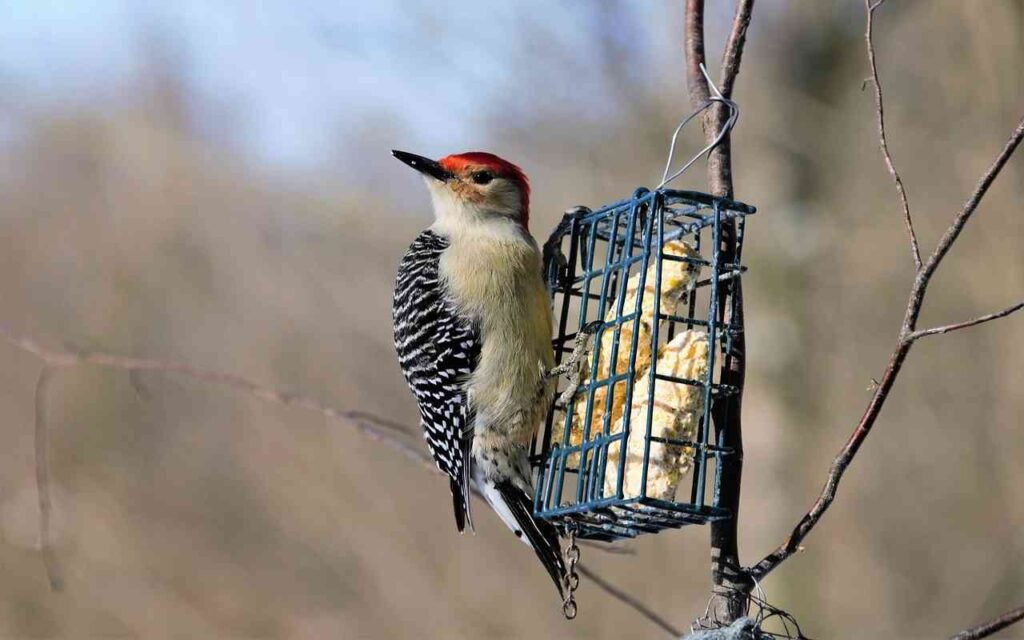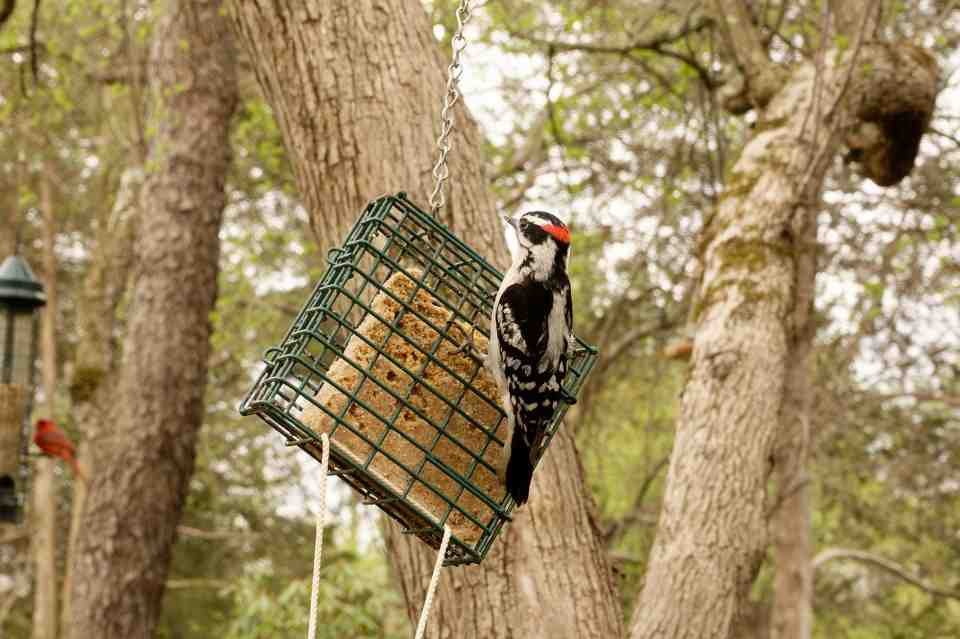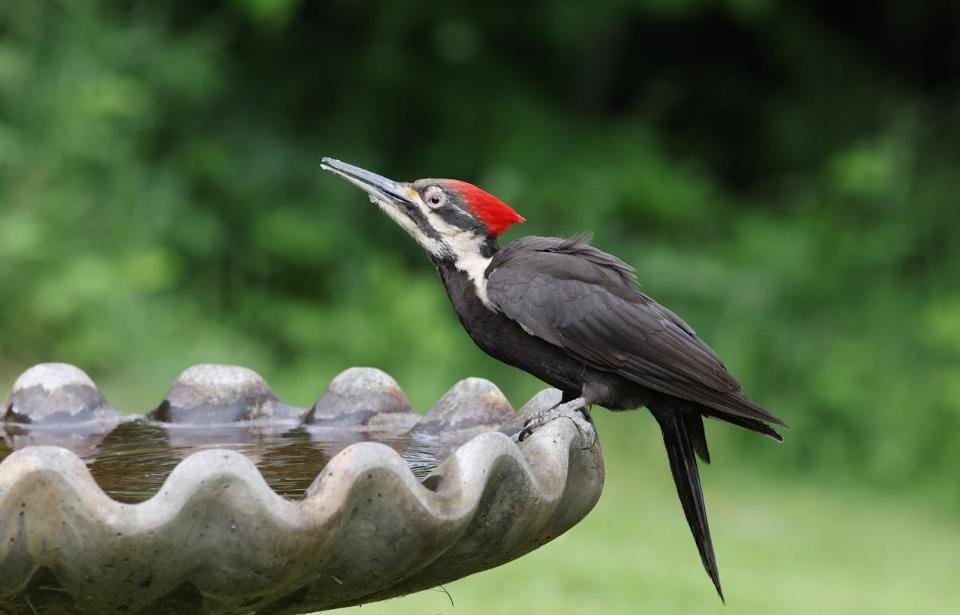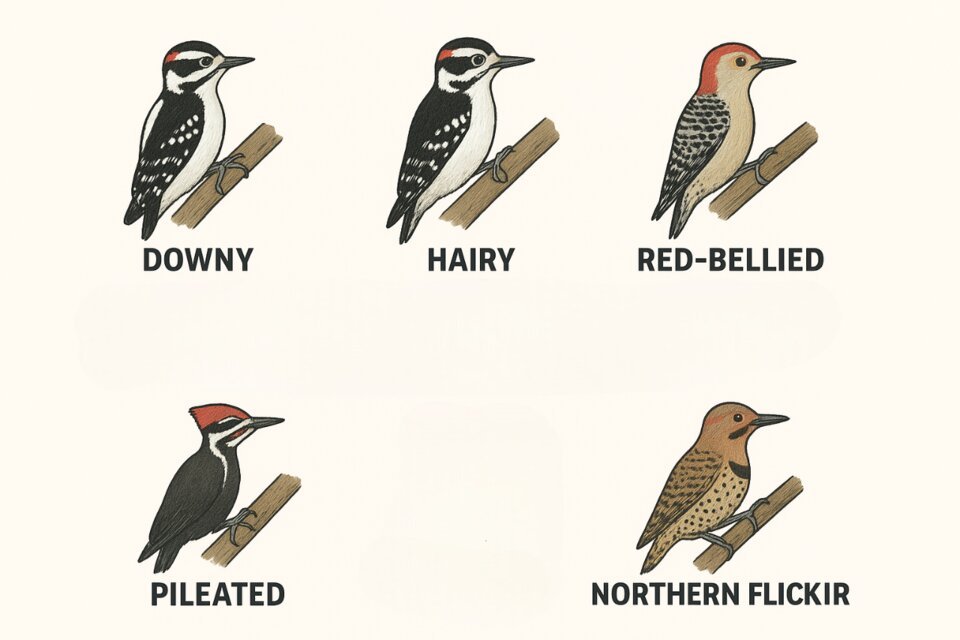Last spring, I heard this insistent drumming sound coming from somewhere near my garage. At first, I thought my neighbor was doing construction at 6 AM (which would have been grounds for war 😑). Turns out, it was a downy woodpecker announcing his territory by hammering on my metal gutter. Loud? Yes. Annoying? A little. But also? Absolutely thrilling. That moment kicked off my obsession with figuring out how to attract woodpeckers to your yard, and honestly, once you get started, there’s no going back.
Woodpeckers are some of the most entertaining birds you can bring to your backyard. They’re acrobatic, vocal, and remarkably bold once they trust your setup. But unlike chickadees who’ll visit any feeder you hang, woodpeckers have specific requirements. Get those right, and you’ll have a front-row seat to one of nature’s most skilled excavators doing their thing in your own yard.
- Provide mature trees, rough bark, and dead wood for food and nesting.
- Hang suet feeders with insects or nuts.
- Offer peanuts, sunflower seeds, and peanut butter.
- Place feeders near trees or trunks for safety.
- Set up shallow or heated water sources.
- Be patient, woodpeckers return once they find your yard.
Understanding What Woodpeckers Need
Before we get into the practical stuff, let’s talk about what woodpeckers actually want from your yard. These aren’t seed-eating perching birds; they’re specialized hunters with very particular habitat preferences.
Woodpeckers spend their lives clinging to vertical surfaces, searching for insects hiding under tree bark and in dead wood. Their entire body plan reflects this lifestyle: stiff tail feathers that act as props, zygodactyl feet (two toes forward, two back) for gripping, and that famous chisel-like beak for drilling. Understanding this helps explain why certain yard features attract them and others don’t.
According to research from Perky-Pet, woodpeckers are drawn to yards that mimic their natural forest habitat. They want mature trees, dead wood for foraging and nesting, and reliable food sources year-round. You don’t need a forest; you just need to provide key elements that woodpeckers associate with good territory.
The good news? Most of what woodpeckers want costs nothing. In fact, attracting woodpeckers often means doing less yard work rather than more. That dead tree you’ve been meaning to remove? It might be the exact feature that brings in a pileated woodpecker. Sometimes the best thing you can do is embrace a little controlled chaos.
Trees for Woodpeckers: The Foundation of Good Habitat
Let’s start with the most important factor: trees. If you want woodpeckers, you need trees. Period. But not just any trees—woodpeckers prefer certain characteristics that provide both food and nesting sites.
Mature trees with rough bark are woodpecker magnets. Oak, hickory, pine, and maple trees all attract various insect species that woodpeckers love to eat. The rough, furrowed bark provides countless hiding spots for beetles, ants, spiders, and other invertebrates. Smooth-barked trees like birch or beech don’t offer the same buffet.
According to a comprehensive meta-analysis published in Ecology and Evolution, woodpeckers show strong selection for large-diameter trees when choosing nest sites. Trees with a diameter at breast height of 43 cm or greater had over a 50% probability of being selected by cavity-nesting birds. Basically, bigger is better when it comes to woodpecker real estate.
If you’re planting new trees specifically to attract woodpeckers, native species are your best bet. Native trees support native insects, which support woodpeckers. Planting a diversity of tree species ensures year-round food availability as different trees attract different insects at different times. Check out our guide on native plants for birds to learn which species work best in your region.
Creating a mini-woodland effect helps too. Information from Zero Waste Homestead suggests planting several trees close together to create a thicket-like area where woodpeckers feel most comfortable. They’re forest birds at heart; a single isolated tree in a lawn doesn’t provide the security they’re looking for.
And here’s the controversial bit: please, please don’t remove dead or dying trees unless they pose a genuine safety hazard. I know they look “messy,” and I know your HOA might give you grief, but dead trees (called snags) are critical woodpecker habitat. We’ll get into that more shortly.
The Critical Importance of Dead Wood
If trees are the foundation, then dead wood is the cornerstone. Woodpeckers don’t just appreciate dead trees—they absolutely require them for both foraging and nesting.
A comprehensive study from the U.S. Forest Service found that woodpeckers prefer snags and trees whose centers have been softened by heartrot for excavating nest cavities. Making a hole in sound, living wood takes enormous energy. Dead or decaying wood is far easier to work with, which is why woodpeckers selectively choose these trees for nesting.
The research published in Ecology and Evolution confirmed that woodpeckers show strong preferences for dead trees and trees with broken crowns. These characteristics indicate internal decay from fungi, which makes excavation easier and attracts the wood-boring insects that woodpeckers feed on. It’s a win-win situation for the birds.
If you’re fortunate enough to have a dead tree or large dead limbs in your yard, consider leaving them standing if safe to do so. Research from Oklahoma State University Extension suggests that leaving approximately one 15-inch diameter or greater dead tree per acre provides essential habitat for cavity-nesting birds. Obviously, most suburban yards aren’t an acre, but even one standing snag can make a difference.
Can’t leave dead trees standing due to safety concerns? Create alternatives. Stack large logs in an out-of-the-way corner to create a woodpile. Mount sections of dead trunk vertically on posts. Leave fallen branches in brushy areas rather than hauling them away. Woodpeckers will forage on horizontal deadwood too, and it provides nesting habitat for other beneficial creatures.
I created a deadwood corner in my yard last year, basically just a pile of logs and branches that I stopped removing. Within two months, I had downy woodpeckers working it over daily. My neighbors probably think I’ve given up on yardwork, but honestly? That corner is more alive with activity than my perfectly manicured front lawn ever was.
Woodpecker Feeders: Bringing Birds Up Close
Now we get to the fun part: feeders. Woodpeckers will visit well-stocked feeders enthusiastically, especially during winter when natural food sources are scarce.
The number one feeder type for woodpeckers is the suet feeder. Suet (animal fat, usually beef) provides the high-calorie fuel woodpeckers need, especially in cold weather. You can buy commercial suet cakes from any bird supply store, and they come in various formulations: plain suet, suet with insects, suet with fruit, suet with nuts. All work well for woodpeckers.
According to experts at Wild Birds Unlimited, suet feeders come in several styles. Cage feeders (simple wire cages that hold suet cakes) work great and are squirrel-resistant if you get the right kind. Tail-prop feeders, which require birds to cling upside-down, actually favor woodpeckers while deterring starlings. Log feeders with pre-drilled holes let you stuff suet or peanut butter directly into the wood, mimicking natural foraging.
Placement matters significantly. Information from Birdseed & Binoculars recommends hanging suet feeders near large trees (within 2-3 feet if possible) so woodpeckers feel secure. They prefer to land on the tree trunk, scope out the situation, then hop over to the feeder. A feeder suspended in open space makes them nervous.
Height isn’t as critical as you might think. I’ve had success with feeders mounted everywhere from 5 to 15 feet off the ground. Some people swear by high-mounted feeders; I’ve found woodpeckers will come to whatever height feels protected by nearby trees.
Beyond suet, woodpeckers also love peanuts. Whole peanuts in the shell, peanut chips, or even regular peanut butter all work. Birds and Blooms suggests smearing peanut butter directly on tree trunks or filling log feeders with it. Just avoid low-fat varieties; woodpeckers need the calories from full-fat peanut butter. If you want to make your own high-energy treats, check out our guide on how to make suet cakes for birds.
Some woodpeckers also eat seeds, particularly black oil sunflower seeds and hulled sunflower chips. Downy and red-bellied woodpeckers will work platform feeders or large hopper feeders where they can perch comfortably. But FYI, suet will always be your MVP for attracting the greatest diversity of woodpecker species.
Suet for Woodpeckers: Choosing the Right Formula
Not all suet is created equal, and understanding what works best can maximize your woodpecker traffic.
Plain suet (just rendered beef fat) is perfectly fine and often the cheapest option. It works year-round, though it can get soft and messy in hot weather. Most commercial suet cakes include binders and other ingredients that hold up better in summer heat.
Suet cakes with added insects (mealworms, crickets, or bug bits) are like crack for woodpeckers. Insects provide protein that pure fat doesn’t, making these formulations especially attractive during breeding season when adults are feeding young. I usually stock insect suet from April through July and see noticeably more activity than with plain suet.
Suet with nuts and berries provides variety and attracts a wider range of birds. Woodpeckers definitely eat these formulations, though they’re not dramatically more effective than plain or insect suet in my experience.
You can also make your own suet if you’re feeling ambitious. Mix rendered beef fat with peanut butter, cornmeal, flour, and dried fruit or nuts. Pack it into molds or spread it in log feeder holes. Homemade suet gives you control over ingredients and often costs less than commercial cakes.
One word of caution: avoid suet formulas with excessive grain fillers or those marketed as “no-melt” that include a lot of vegetable shortening. Woodpeckers want fat and protein, not carbs. Read ingredients and choose formulations heavy on actual suet, nuts, and insects.
Creating a Bird-Friendly Garden with Water Features
Woodpeckers need water just like any bird, and providing water for birds can be a major attractant, especially in dry climates or during hot summers.
A simple birdbath works perfectly well. Woodpeckers don’t require anything fancy, but they do appreciate shallow water (1-2 inches deep) with rough surfaces that provide good footing. I’ve seen downy woodpeckers belly-flopping in my birdbath with the enthusiasm of kids at a swimming pool. It’s absurdly entertaining 🙂
Place your birdbath near trees but in a relatively open spot where birds can see approaching predators. Woodpeckers are cautious bathers and won’t use a bath that feels like a trap. According to Dan’s Bird Bites, positioning the bath in a low-traffic area near shelter increases woodpecker usage.
Moving water is even more attractive than still water. The sound draws birds from greater distances, and moving water stays fresher longer. You can add a simple solar fountain to your existing birdbath or invest in a recirculating dripper. I added a cheap solar fountain to my bath last summer and saw an immediate increase in bird visits, including species I’d never seen at my regular bath.
Keep water sources clean and ice-free. During winter, a heated birdbath becomes the hottest ticket in town (pun intended). When natural water sources freeze, birds flock to reliable heated sources. I’m convinced my heated birdbath is why I see pileated woodpeckers in January. Learn more about keeping birds hydrated during summer to understand seasonal water needs.
Don’t forget that woodpeckers also get moisture from sap and from the insects they eat. But providing clean, reliable water sources makes your yard more attractive to all bird species, and it’s especially important during drought conditions or extreme temperatures.
Woodpecker Nesting Habits: Providing Cavity Sites
Understanding woodpecker nesting habits helps you create habitat that supports breeding pairs, not just feeding visitors.
Most woodpeckers are primary cavity excavators, meaning they create their own nest holes in dead or dying trees. Once they’ve excavated a cavity (which takes weeks of work), they’ll use it for one breeding season, then often abandon it. These cavities then become crucial habitat for secondary cavity nesters like chickadees, nuthatches, screech owls, and flying squirrels.
The research from Ecology and Evolution found that woodpeckers typically nest in trees with significant decay, particularly trees with broken crowns that indicate internal heartrot. These trees are structurally compromised enough to excavate but stable enough to provide protection. It’s a delicate balance that woodpeckers are expert at assessing.
Cavity height varies by species. Smaller woodpeckers like downys typically excavate cavities 5-15 feet up. Larger species like pileated woodpeckers nest higher, often 15-70 feet above ground. All prefer cavities with entrance holes just large enough for their bodies, which helps exclude larger predators.
If you lack suitable natural nesting sites, you can install nest boxes for smaller woodpecker species. Downy, hairy, and red-bellied woodpeckers will sometimes use properly sized boxes. Pack the boxes with wood chips (not sawdust) to simulate the natural excavation process. Some woodpeckers will excavate the chips themselves; others will use boxes as-is. For more on encouraging birds to nest in your garden, check out our comprehensive guide.
Mount nest boxes on trees or poles in relatively quiet areas of your yard. Woodpeckers prefer nesting sites away from heavy human activity. The entrance hole should face away from prevailing winds and afternoon sun if possible.
The absolute best thing you can do for nesting woodpeckers? Leave standing dead trees and large dead limbs in place. According to the U.S. Forest Service research, it takes several years after a tree dies before it becomes ideal nesting habitat. Fresh dead trees are too hard; heavily decayed trees are too soft and unstable. The sweet spot is 3-7 years post-death when decay has progressed enough for easy excavation but structural integrity remains intact.
Backyard Bird Feeding Strategy for Year-Round Woodpeckers
Creating an attracting birds to yard strategy that works year-round requires thinking about seasonal food availability and woodpecker behavior throughout the annual cycle.
Spring and summer are breeding season for most woodpeckers. During this time, they’re hunting insects voraciously to feed hungry chicks. Continue offering suet, but don’t be surprised if visitation drops as natural food becomes abundant. Woodpeckers are out there foraging on trees, stripping bark, and drilling into wood to access larvae and beetles. This is also when territorial drumming peaks as males establish and defend breeding territories.
Fall is migration time for some woodpecker species and preparation time for residents. Yellow-bellied sapsuckers migrate south, while most other North American woodpeckers are year-round residents. Resident species start caching food in fall, hiding seeds and nuts in bark crevices for winter retrieval. IMO, this is when woodpecker activity at feeders starts ramping up again as birds search for high-calorie foods to cache.
Winter is prime woodpecker-watching season. Natural food sources are scarce, and competition for resources intensifies. This is when consistent feeding makes the biggest difference. Keep multiple suet feeders stocked, offer peanuts, and maintain water sources. I’ve counted eight different woodpecker individuals at my winter feeders on busy days, including species I rarely see in summer. Our article on feeding birds in winter covers additional strategies for supporting your local woodpecker population.
Consistency matters more than quantity. Woodpeckers learn where reliable food sources exist and incorporate them into daily foraging routes. Don’t let feeders sit empty for weeks at a time. Once woodpeckers establish your yard as a dependable food source, they’ll visit regularly and often bring their fledglings after breeding season.
Attracting Specific Woodpecker Species
Different woodpecker species have slightly different preferences. Let’s break down what appeals to common species you might attract:
Downy Woodpeckers are the smallest and most common. They’ll visit any suet feeder, readily use nest boxes, and are comfortable in suburban settings. They prefer smaller trees and are often the first woodpecker species people attract. If you’re just starting out, downy woodpeckers will likely be your gateway species. Want to tell them apart from their larger cousins? Check out our comparison of downy vs hairy woodpecker.
Hairy Woodpeckers look like larger versions of downys but are more cautious. They prefer mature forests and are choosier about feeder placement. Mount feeders on or very near large tree trunks to make hairies feel secure. Once they trust your setup, they’re reliable visitors.
Red-bellied Woodpeckers are adaptable and increasingly common in suburban areas. They love suet, peanuts, and will even eat oranges and grape jelly. They’re also frequent birdbath users. Red-bellies nest in dead trees but will use nest boxes readily.
Pileated Woodpeckers are the holy grail for many bird watchers. These crow-sized woodpeckers need large territories with extensive dead wood. If you live near mature forest and have standing snags or large dead limbs, you have a chance of attracting pileateds. They prefer horizontal log suet feeders over hanging cages and need space to maneuver their large bodies. I’ve been lucky enough to have a pair visit my suet logs periodically, and every visit feels like Christmas morning.
Northern Flickers are ground-feeding woodpeckers that love ants. They’ll visit elevated suet feeders but also forage on lawns for ants and beetles. If you want flickers, reduce or eliminate pesticide use so ant populations can thrive. Flickers also love birdbaths and are less reliant on large trees than other species. Learn more about this unique species in our article on fun facts about the northern flicker.
Common Mistakes to Avoid
Let’s talk about what doesn’t work, because I’ve made basically every mistake possible in my quest to attract woodpeckers.
Mistake number one: Removing all dead wood. I get it; dead trees look “untidy.” But they’re the single most important habitat feature for woodpeckers. Before you remove that dead tree, honestly assess whether it poses an actual safety risk. If it’s not threatening structures or high-traffic areas, leave it.
Mistake number two: Using cheap, low-quality suet. That 99-cent suet cake that’s mostly grain filler and vegetable shortening? Woodpeckers will ignore it. Invest in quality suet formulations with actual fat and protein. It’s more expensive but dramatically more effective.
Mistake number three: Pesticide use. Woodpeckers eat insects—lots of them. When you spray your yard with broad-spectrum insecticides, you’re eliminating the primary food source woodpeckers need. If you want woodpeckers, embrace a few bugs. Your yard will be healthier for it, and the woodpeckers will help control problem insects naturally. Consider using native plants instead, which naturally attract beneficial insects without chemicals.
Mistake number four: Expecting instant results. Unlike chickadees who’ll find a new feeder within hours, woodpeckers take time to discover and trust new food sources. It might take weeks or even months before woodpeckers become regular visitors. Be patient and consistent.
Mistake number five: Ignoring placement. Woodpeckers want security. Feeders hanging in open space away from trees rarely attract woodpeckers. Mount or hang feeders on or near tree trunks where woodpeckers can quickly retreat to safety.
Conclusion
Attracting woodpeckers to your yard isn’t rocket science, but it does require understanding what these specialized birds need. Mature trees, dead wood for foraging and nesting, quality suet feeders placed strategically, reliable water sources, and a bit of patience will transform your yard into woodpecker habitat.
The best part? Most of what woodpeckers want doesn’t cost money—it costs restraint. Leave that dead branch. Skip the pesticides. Let a corner of your yard go a little wild. These simple acts of less-is-more yard management create habitat for woodpeckers and dozens of other species that depend on the features we’re often taught to remove.
My yard isn’t perfect. There’s a dead cherry tree in the back corner that I absolutely should have removed three years ago but haven’t. There are log piles and brush heaps that would horrify any HOA. My suet feeders go through more cycles than I’d like to admit because woodpeckers hit them hard. And you know what? It’s the best my yard has ever been.
This morning, I watched a red-bellied woodpecker work over the bark of an old oak while a pair of downy woodpeckers squabbled over the suet feeder. The same tree where a hairy woodpecker excavated a nest hole last spring was being investigated by a titmouse looking for a nesting site this year. All this action from birds using resources I didn’t even know I was providing until I started paying attention.
Start simple. Put up a suet feeder near a mature tree. Leave some dead wood in place if possible. Add a birdbath. Then watch what happens. Once woodpeckers discover your yard provides what they need, they’ll become regular visitors, bringing entertainment, pest control, and a connection to the natural world that’s absolutely worth the effort. Trust me, once you’ve attracted your first pileated woodpecker, there’s no going back.





